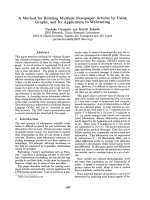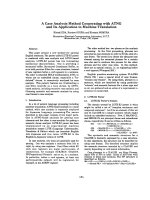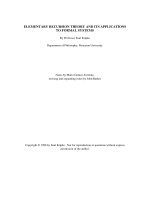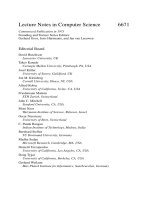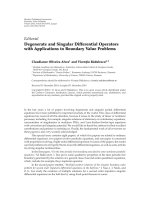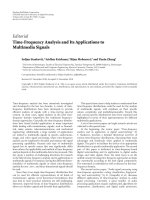Multiple knapsack problem with inter related items and its applications to real world problems
Bạn đang xem bản rút gọn của tài liệu. Xem và tải ngay bản đầy đủ của tài liệu tại đây (2.42 MB, 73 trang )
MULTIPLE KNAPSACK PROBLEM WITH
INTER-RELATED ITEMS AND ITS APPLICATIONS
TO REAL WORLD PROBLEMS
ANG JUAY CHIN
(B.Sc (Computer and Information Sciences), NUS)
A THESIS SUBMITTED
FOR THE DEGREE OF MASTER OF SCIENCE
DEPARTMENT OF COMPUTER SCIENCE
NATIONAL UNIVERSITY OF SINGAPORE
2003
Abstract
Motivated by a real world application, we study a variant of the classic
knapsack problem, which we call the Multiple Knapsack Problem with Inter-related
Items (MKPIR). We are given a set of items and a set of knapsacks of limited capacity.
For each item, a set of knapsacks that can hold that item is specified. In addition,
binary relationships may exist between the items. These relationships affect the profit
of having that item in the knapsack in consideration. In this thesis, we adopted a few
heuristics and test them on the venue assignment problem, instance of MKPIR, using
actual data and randomly generated test instances.
Keywords:
Multiple knapsack problem, Venue assignment problem
Acknowledgements
I would like to express my sincere gratitude to my supervisor A/P Andrew Lim
for his sound advice through the course of my study. I would also like to thank my cosupervisor Dr Tan Sun Teck for his guidance.
Lastly, I would like to express my heart felt love and appreciation to my family
especially my husband Wee Kit for their support, patience and love during this period.
i
Table of Contents
Chapter 1 Introduction ................................................................................................ 1
1.1
Motivation................................................................................................... 1
1.2
Examination Timetabling Problem ............................................................. 2
1.3
Venue Assignment Problem ....................................................................... 3
1.4
Thesis Outline ............................................................................................. 6
Chapter 2 Multiple Knapsack Problem....................................................................... 8
2.1
Multiple Knapsack Problem with Inter-related Items................................. 9
2.2
Formulation of VAP as MIN_MKPIR...................................................... 10
2.3
Related Work ............................................................................................ 13
Chapter 3 System User Interface .............................................................................. 14
3.1
Exam Scheduler ........................................................................................ 14
3.2
Venue ........................................................................................................ 16
3.3
Venue Assignment .................................................................................... 17
3.4
Seat Assignment........................................................................................ 18
Chapter 4 Heuristics.................................................................................................. 19
4.1
Greedy Method ......................................................................................... 20
4.2
Tabu Search .............................................................................................. 20
4.3
Simulated Annealing................................................................................. 22
4.4
Operators................................................................................................... 26
ii
4.4.1
Relocate Operator ................................................................................. 26
4.4.2
Exchange Operator................................................................................ 27
4.4.3
Multi-Exchange Operator ..................................................................... 29
4.5
“Squeaky Wheel” Optimization................................................................ 30
4.6
Combining “Squeaky Wheel” Optimization and Tabu Search................. 34
Chapter 5 Experimental Results................................................................................ 36
5.1
Experimental Data .................................................................................... 36
5.2
Evaluation of the Assignment Quality...................................................... 42
5.3
Implementation Matters ............................................................................ 45
5.4
Results....................................................................................................... 46
Chapter 6 Conclusions .............................................................................................. 60
6.1
Project Summary....................................................................................... 60
6.2
Directions for Future Work....................................................................... 60
Bibliography ............................................................................................................. 63
iii
List of Figures
Figure 1: Venue Assignment Problem as an instance of a MKPIR.............................. 12
Figure 2: Exam Scheduler............................................................................................. 14
Figure 3: Edit Venue Layout......................................................................................... 16
Figure 4: Venue Assignment ........................................................................................ 17
Figure 5: Seat Assignment ............................................................................................ 18
Figure 6: Tabu Search................................................................................................... 21
Figure 7: Simulated Annealing ..................................................................................... 25
Figure 8: Relocate Operator.......................................................................................... 26
Figure 9: Exchange Operator ........................................................................................ 28
Figure 10: The Construct/Analyze/Prioritize cycle ...................................................... 30
Figure 11: Relationship Cost for 0102_sem2 ............................................................... 50
Figure 12: Relationship Cost for 0203_sem1 ............................................................... 50
Figure 13: Relationship Cost for 0203_sem2 ............................................................... 51
Figure 14: Relationship Cost for many relationships test instances ........................... 55
Figure 15: Relationship Cost for many items, few knapsacks test instances ............. 57
Figure 16: Relationship Cost for few items, many knapsacks test instances ............. 57
iv
List of Tables
Table 1: Characteristics of 0102_sem2......................................................................... 37
Table 2: Characteristics of 0203_sem1......................................................................... 37
Table 3: Characteristics of 0203_sem2......................................................................... 37
Table 4: List of Examination Venues for 0102_sem2 .................................................. 38
Table 5: List of Examination Venues for 0203_sem1 .................................................. 39
Table 6: List of Examination Venues for 0203_sem2 .................................................. 40
Table 7: Generated Problem Instances ......................................................................... 42
Table 8: Results for 0102_sem2 ................................................................................... 47
Table 9: Results for 0203_sem1 ................................................................................... 48
Table 10: Results for 0203_sem2 ................................................................................. 49
Table 11: Computational Time for 0102_sem2............................................................ 52
Table 12: Computational Time for 0203_sem1............................................................ 52
Table 13: Computational Time for 0203_sem2............................................................ 52
Table 14: Results for many relationships test instances ............................................. 53
Table 15: Results for many items, few knapsacks test instances ............................... 54
Table 16: Results for few items, many knapsacks test instances ............................... 54
Table 17: Computational Time for many relationships test instances........................ 57
Table 18: Computational Time for many items, few knapsacks test instances.......... 58
Table 19: Computational Time for few items, many knapsacks test instances.......... 58
v
Summary
In the Multiple Knapsack Problem, N items of different sizes have to be
packed into M knapsacks with limited volume. Each item i has an associated profit
p i and weight wi . The problem is to select N disjoint subsets of items, such that subset
i fits into knapsack i and total profit of the selected items is maximized.
Motivated by a real world application, we study a variant of MKP, the
Multiple Knapsack Problem with Inter-related Items (MKPIR). In MKPIR, binary
relationships may exist between items.
Consider two items, i and j, packed in
knapsacks x and y respectively. If there exists a relationship rij between the two items,
then the value of the relationship between i and j is rij ⋅ k xy where k xy is the distance
measure between knapsacks x and y. Accordingly, item i has profit pix = ∑ j =1 rij k xy
N
when considered for inclusion in knapsack x . Thus, unlike most other variants of
MKP in which the profit/cost of item i is fixed, p i , the value of item i in MKPIR is a
variable. In addition, an assignment restriction is imposed on the items. For each item i ,
a set of knapsacks that can hold item i is specified. In a feasible assignment of items
to knapsacks, each item is assigned to at most one knapsack, assignment restrictions
are satisfied, and knapsack capacities are not exceeded, with the objective of
M
maximizing
N
∑∑ p
x =1 i =1
ix
z ix , where zix = 1 if item i is assigned to knapsack x and
zix = 0 otherwise.
The Venue Assignment Problem (VAP) is a sub-problem in an exam-timetable
scheduling application. In this application, examinations for modules are assigned
exam timeslots based on the estimated enrolment figures, disregarding the actual
vi
examination venue. Specific venues are only allocated when the actual enrolment
figures for modules are known after student registration. Each day of the examination
period is divided into a few non-overlapping exam sessions. Venues may be physically
far apart, and some candidates may be required to take more than one exam a day and
have to travel between venues. Thus, in addition to assigning examinations to venues
without violating the venue capacity constraint, we would like to minimize the
distance that candidates have to travel between their examinations each day.
The problem of assigning exams to venues so as to minimize student
movement can be formulated as an instance of MIN_MKPIR (a minimization version
of MKPIR). The assignment of exams to each exam timeslot is restricted to only
venues available during that timeslot. The distance that needs to be traveled by
candidates of exam i to his next exam j on the same day will be translated into cost for
both exam i and exam j. Each exam day may be viewed as a separate VAP, since
exams scheduled on different days are independent.
Various heuristics such as Tabu Search, Simulated Annealing and “Squeaky
Wheel Optimization” are experimented on the MKPIR using actual data from the
National University of Singapore and generated test data. Preliminary results based on
our experimentations shows that Simulated Annealing and “Squeaky Wheel
Optimization” with Tabu Search post-optimization produce satisfactory results.
Although more work still need to be done on solving the MKPIR efficiently, we
believe that our heuristics will be useful for solving VAP and other real world
problems of similar characteristics.
vii
Chapter 1
Introduction
1.1
Motivation
Our variant of the multiple knapsack problem, multiple knapsack problem with
inter-related items was motivated by a sub-problem in the timetabling problem in the
National University of Singapore (NUS). NUS conducts more than 1500 modules for
about 25 000 students every semester. In 1993, a modular course system was adopted
by NUS. Under this modular system, students progress at their own pace and choose
the modules that they wished to study, subject to timetable arrangements, in order to
complete their degree requirements. In addition, students can choose from a wide
range of modules, called cross-faculty modules, offered by different faculties. As a
result of this flexibility for students, the task of scheduling examination timetables in
NUS became much more complex.
Previously, the scheduling of examination timetable in NUS was done
manually. This was a tedious and error-prone process that typically took months to
process. Critical conflicts where a student was scheduled to take examinations at the
same time were not always detected, and correcting these mistakes was cumbersome
and expensive. A team was thus funded by NUS to develop an automated campuswide examination timetabling system, UTTSExam [Lim et al. 2000].
1
CHAPTER 1 INTRODUCTION
Scheduling of examinations in UTTSExam is a two steps process. Examinations
for modules are first assigned timeslots based on estimated enrolments without venues.
Specific venues are only assigned in the second phase when actual enrolment figures
are known. This created the venue assignment problem and motivates the study of the
multiple knapsack problem with inter-related items in this report.
1.2
Examination Timetabling Problem
The primary objective of an examination timetabling problem is to schedule all
examinations into available timeslots without hard constraints violation. Many
practical examination timetabling problems are however much more complex and
usually include the assignment of examinations to various venues of varying capacities
and the satisfying of various timetable constraints. These timetable constraints may be
hard or soft constraints. The satisfaction of hard constraints is considered essential to a
feasible timetable, whereas the satisfaction of soft constraints is considered desirable
but not essential. A high quality timetable is one that meets all the conditions of a
feasible timetable and minimizes the violation of these soft constraints.
It is the University’s policy to schedule all examinations before student
enrolment. The automated examination timetable scheduler hence has to schedule
examinations based on estimated enrolment figures put forward by the various
faculties. These enrolment estimates are however not accurate and are often underestimated or over-estimated. As such, to better utilize available resources, specific
venues are only assigned after student registration.
2
CHAPTER 1 INTRODUCTION
A hybrid of centralized and de-centralized approach is adopted for timetabling
in UTTSExam [Lim et al. 2002]. Scheduling of examination timetable is carried out in
two phases. In the first phase, before student registration, the examination’s enrolment
estimates were used to proportionally allocate a fixed number of seats for each faculty
(called their venue partition). Each faculty then scheduled their exams according to
their venue partition, disregarding the actual venues. These faculty timetables are then
merged into a campus-wide tentative timetable. The central authority will resolve any
conflicts that arise during the merging that are caused by modules offered to more than
one faculty. Specific venues are only allocated in the second phase when the actual
enrolment figures for modules are known after student registration. This approach
proved to create a much better timetable than a fully centralized approach.
Furthermore, it allows the individual faculty timetable administrators to retain a high
level of control over their personal timetables, which would not have been possible in
a fully centralized system.
1.3
Venue Assignment Problem
The venue assignment problem (VAP) is a sub-problem of the examination
timetabling problem in UTTSExam. The objective is to assign a set of examinations
with known timeslots to venues with limited capacities while minimizing travelling
required by candidates who have back-to-back examinations.
Each day of the examination period is divided into a few non-overlapping
examination sessions. Due to the limited amount of spaces suitable to hold
examinations on-campus, off-campus venues have to be included. Examination venues
3
CHAPTER 1 INTRODUCTION
thus may be physically far apart. Candidates who are required to take more than one
examination a day may thus have to travel between on-campus venues and off-campus
venues.
Starting 2002/2003 academic year, NUS decided to do away with commercial
venues for examinations. Instead, multiple small rooms located around campus are
made available to make up the deficit. Though this has resulted in a substantial
monetary savings in rental cost, candidates with back-to-back examinations are not
spared from having to travel between far apart examination venues within the campus.
As individual faculties do not have enough venue capacity to hold all examinations
conducted by their own faculties, central venues have to be used. In addition, due to
the existence of cross-faculty modules which is taken by students from different
faculties, it is inevitable that some candidates may have to travel between examination
venues.
It is the University policy that examination timetable is planned and released
before student registration so that students have a greater control over their
examination schedule. Since, student registration data is not available during timetable
scheduling, it is therefore not within the examination timetable scheduler control to
minimize the number of back-to-back examinations. The best that the examination
timetable planner can do is to update the automatic timetable scheduler with
constraints that ensure that certain examinations are placed at least a number of
sessions apart. These constraints may be based on popular module combinations taken
by past year students. The scheduler will avoid planning examinations of these
4
CHAPTER 1 INTRODUCTION
modules on back-to-back sessions. All these are however just predictions and will not
guarantee that the number of back-to-back examinations for students is minimized.
Under these circumstances, it is important that the number of candidates that
needs to travel between examination venues be kept to the minimum, otherwise traffic
control will be chaotic during the exam session interval. It is therefore one of the
objectives in VAP to minimize student movement; that is the distance that candidates
have to travel between back-to-back examinations each day.
Additionally, assignment restrictions, which we call venue constraints in VAP,
must not be violated, since some examinations must be held in a specific type of venue.
For instance, some examinations must be held in drawing rooms with big tables since
large drawing papers are involved during the examination, while other papers should
not be held in the drawing rooms.
Before, the assignment of venues to examinations was done manually in the
second phase of the examination timetable planning exercise, weeks before the start of
the examination period. The assignment of venues to examinations has to be carefully
managed manually. Student movement has to be painstakingly calculated and venue
constraints have to be satisfied. A careless assignment that results in massive group of
students having to travel between far-away venues not only causes great inconvenience
to students but will also impose a heavy burden on the school transportation system.
We see that the venue assignment problem plays an important part in the
goodness of the examination timetable in UTTSExam. Since no matter how good the
examination timetable is in the first phase of the scheduling process, a bad venue
assignment in the second phase will eventually lead to an overall poor solution. A
5
CHAPTER 1 INTRODUCTION
venue assignment that results in many candidates having to travel between far-away
venues for exams on the same day is deemed to be a poor assignment.
In the event of an emergency (for example, Severe Acute Respiratory
Syndrome (SARS) outbreak) when the University needs to re-assign examinations to
venues within a very short period of time, a venue assignment engine will be very
critical and handy. This was the situation for examinations in semester 2 2002/2003
when SARS outbreak occur just a few weeks before the examination period. As SARS
can be spread by droplet infection and close contact with SARS patients, the university
has to make re-arrangements for examinations to limit exposure and risk
( This includes reducing the size of groups
by de-centralizing exams to many venues and increasing the table to table distance in
venues. The increase in table to table distance caused a drop of more than 20% in the
number of seats available in the examination venues used. For example, for one of the
major exam venue, Multi-Purpose Hall 1, the number of seats available decreases from
850 to 660. The availability of a venue assignment engine could quickly perform a reassignment and advise if more venues are required.
We show that the problem of assigning examinations to venues can be modeled
as a multiple knapsack problem in chapter 2.
1.4
Thesis Outline
In this thesis, we study the Multiple Knapsack Problems with Inter-related
Items (MKPIR), which is a variant of MKP, in which binary relationships exist
between items and adopted a few heuristics for solving knapsack problems of this
6
CHAPTER 1 INTRODUCTION
variant. Practical applications for MKPIR include the venue assignment problem and
shelf space allocation problem (SSAP)[Yang 2001]. Chapter 2 explains the MKPIR in
details and models the VAP as an instance of MKPIR. Chapter 3 shows some
interesting user interfaces and key functionalities offered by the UTTSExam System. In
Chapter 4, various heuristics are presented. They include Tabu Search, Simulated
Annealing and “Squeaky Wheel Optimization”. We have attempted to post-optimized
the results from “Squeaky Wheel Optimization” using Tabu Search. In Chapter 5, we
demonstrate the effectiveness of our heuristics by studying its use on VAP, a
subproblem of an examination-scheduling problem, based on real data from the
National University of Singapore and generated test instances. The details of the
experiments performed using these heuristics and hybrids are given and our
experimental results are analyzed. Finally, in Chapter 6 we discuss possible future
works and present our conclusions.
7
Chapter 2
Multiple Knapsack Problem
Knapsack Problems have been intensively studied since the emergence of
Combinatorial Optimization due to their many applications in industry and financial
management. They also appear as a sub-problem in many more complex algorithms,
and these algorithms will benefit from any improvement in this field. The family of
knapsack problems all considers a set of items, each associated with a profit and
weight. The objective is to choose a subset of the given items such that the
corresponding profit sum is maximized without exceeding the capacity of the
knapsack(s). Different types of Knapsack Problems arise depending on the distribution
of items and knapsacks and the constraints involved.
In the multiple knapsack problem (MKP)[Martello and Toth, 1990; Pisinger
and Toth 1998], N items of different sizes have to be packed into M knapsacks with
limited volume. Each item j has an associated profit p j and weight w j . The problem
is to select M disjoint subsets of items, such that subset i fits into knapsack i and total
profit of the selected items is maximized.
In this report, we study the Multiple Knapsack Problems with Inter-related
Items, a variant of MKP, in which binary relationships exist between items. The next
section shall describe the problem in detail.
8
CHAPTER 2 MULTIPLE KNAPSACK PROBLEM
2.1
Multiple Knapsack Problem with Inter-related Items
In Multiple Knapsack Problems with Inter-related Items (MKPIR), we are
given a set of N items to be packed into a set U of M knapsacks. Each item i has a
positive weight wi , and each knapsack x has a limited capacity vx . In addition, binary
relationships may exist between items.
Consider two items, i and j , packed in
knapsacks x and y respectively. If there exists a relationship rij between the two items,
then the value of the relationship between i and j , is rij k xy where k xy is the distance
measure
between
knapsacks
x
and
y.
Accordingly,
item i
has
profit
pix = ∑ j =1 rij k xy when considered for possible inclusion in knapsack x . Thus, unlike
N
most other variants of MKP in which the profit of item i is a constant, the value of
item i in MKPIR, p ix varies. The value of p ix depends on the relationship of item i
with other items and the knapsack solution. In addition, an assignment restriction is
imposed on the items. For each item i , a set A i ⊆ U of knapsacks that can hold item i
is specified. The objective is to
M
maximize
N
P = ∑∑ pix z ix
(1)
x =1 i =1
N
subject to
∑w z
i =1
i ix
≤ vx , x = 1,..., M .
(2)
where zix = 1 if item i is assigned to knapsack x and zix = 0 otherwise
and that assignment restrictions are satisfied.
9
CHAPTER 2 MULTIPLE KNAPSACK PROBLEM
The minimization version of the problem MIN_MKPIR is obtained by defining
cix as the cost required to assign item i to knapsack x . However, to simply replace p ix
M
N
by cix and state the objective of MIN_MKPIR as minimize ∑∑ cix zix alone allows for
x =1 i =1
the trivial solution with 0 cost where no items are assigned to any knapsack. Hence
MIN_MKPIR is defined as
M
N
∑∑ c
minimize
x =1 i =1
N
∑w z
subject to
i =1
(3)
z
ix ix
i ix
≤ vx ,
x = 1,..., M .
(4)
where zix = 1 if item i is assigned to knapsack x and zix = 0 otherwise
N
while maximizing
∑w z
i =1
i ix
where x = 1,..., M and that assignment restrictions are
satisfied. Section 5.2 will discuss in detail how we evaluated these objectives in
MKPIR.
2.2
Formulation of VAP as MIN_MKPIR
The problem of assigning examinations to venues so as to minimize travel
distance for candidates, subjected to assignment restriction, can be formulated as an
instance of the MIN_MKPIR.
Each examination day may be viewed as a separate VAP, since examinations
scheduled on different days are independent. It is not a concern if candidates have to
10
CHAPTER 2 MULTIPLE KNAPSACK PROBLEM
take an examination in venue x on one day and another examination in venue y the
next day.
In VAP, item refer to examination and the number of candidates for
examination i , which we also refer to as size of examination i is denoted by wi . Due
to the nature of the problem, all candidates for each examination i must be assigned an
examination venue. The assignment of examinations to venues in each examination
timeslot is restricted to only the venues applicable during that timeslot. For each item i ,
Ai is the set of venues applicable in the timeslot in which examination i is scheduled,
while taking its venue constraint into consideration.
The distance that needs to be traveled by candidates of examination i to
examination j which is scheduled on consecutive timeslots on the same day is
translated into cost for both examinations i and j. The number of candidates that need
to sit for both examinations i and j , 1 ≤ i, j ≤ M , is represented by rij . If examination
i is held in venue x while examination j is held in venue y , then k xy is the distance
between venue x and venue y . Hence rij candidates will need to travel k xy distance if
examination i is held in venue x while examination j is held in venue y . Cost of
holding examination i in venue x is thus cix = ∑ j =1 rij ⋅ k xy .
N
A good solution to the venue assignment problem is one with minimum
M
N
cost ∑∑ cix z ix and that packed as many exams as possible without splitting across
x =1 i =1
multiple venues.
11
CHAPTER 2 MULTIPLE KNAPSACK PROBLEM
Session AM
Venue
1
Venue
2
8km
Venue
3
Exam
A
Exam
B
…
Other
exams
5km
100 students
20km
Session PM
57 students
Venue
1
Venue
2
8km
Exam
P
Venue
3
18 students
Exam
Q
…
Other
exams
5km
20km
Session EV
13 students
Venue
1
Venue
2
Venue
3
Exam
X
125 students
Exam
Y
…
Other
exams
Figure 1: Venue Assignment Problem as an instance of a MKPIR
Figure 1 shows a venue assignment problem for an examination day. The
number of candidates that have to sit for back-to-back examinations is shown along the
dotted line. The distance k xy between two venues is shown on the solid line. For
example, if there are 57 students who take both examination B and examination P
( rBP = 57 ), and examination B is assigned to venue 1 while examination P is assigned
to venue 2, then 57 students will have to travel from venue 1 to venue 2 for their next
examination. Cost of holding examination B in venue 1 will be 57 × 20 since the
distance between venue 1 and venue 2, k12 = 20 .
12
CHAPTER 2 MULTIPLE KNAPSACK PROBLEM
2.3
Related Work
MKP is NP-hard in the strong sense [Martello and Toth 1990] and thus no fully
polynomial approximation scheme can be found unless P = NP [Garey and Johnson
1979]. Several exact algorithms and approximation algorithms have been presented to
solve the multiple knapsack problem.
[Hung and Fisk 1978] presented a depth-first branch and bound algorithm
where the upper bounds were derived by either Lagrangian relaxation or surrogate
relaxation. Choice of the item selected at each level of the decision then depends on
the relaxation used. In the Lagrangian case, the algorithm selects the item which had
been inserted in the most knapsacks. While in the surrogate case, among all the items
that are not assigned, the item with the lowest index is selected. The items are sorted
according to
p
p1 p2
≥
≥ ... ≥ N and the knapsacks are sorted in non-increasing order.
w1 w2
wN
Previous work on MKP and its variants [Shachnai and Tamir, 2001][Dawande
and Kalangnanam 1998] however assume that (i) items are not related and that
relationship between items has no effect on the assignment, (ii) profit/cost of items has
a fixed value, regardless of the knapsack it is being assigned to and its relationship
with other items, and (iii) items may be assigned to any knapsack as long as the
capacity of the knapsack is not exceeded. Though 1 2 -approximation algorithms were
presented in [Dawande et al. 2000] for a MKP with assignment restriction, profit/cost
of items is however fixed and there is no relationship between the items.
13
Chapter 3
System User Interface
This chapter shows some of the key functions and screenshots of the
UTTSExam System.
3.1
Exam Scheduler
Figure 2: Exam Scheduler
14
CHAPTER 3 SYSTEM USER INTERFACE
Figure 2 is the screen that allows examination timetable to be scheduled based
on enrolment estimates and other timetable constraints entered. The main scheduling
window is a cross-table with each row representing an examination session, and each
column representing a venue partition (e.g. big venues BIG_V and small venues SM_V).
This window has two views, Zoom Out and Zoom In view. The Zoom Out view allows
entire timetable structure to be viewed without giving too many details, and is useful
when the user just wish to have an overview of the timetable. The Zoom In view
expands the cross-table to give the number of examinations and the remaining capacity
(in terms of number of seats filled / total capacity) for each partition/session pair. The
timetable may be changed manually. All slots which are available and will not cause
any constraints violation for the selected examination will be highlighted to the user.
15
CHAPTER 3 SYSTEM USER INTERFACE
3.2
Venue
Figure 3: Edit Venue Layout
One of the tasks of an examination timetabling scheduling system is to place
examinations into the various venues in various timeslot, subjected to several
constraints and to assign each candidate a seat for each examination. As such,
particulars like capacity, layout, and available dates of the venues need to be defined.
Figure 3 shows one of the screens for editing layout of venues. In this screen,
arrangements of walls, doors and seats within a venue can be specified. In order for
venues with large number of seats to be more manageable, the facility enables seats to
be divided into different sections.
16


